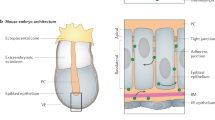Abstract
ACCORDING to the morphogen gradient concept1á¤-5, cells in one part of an embryo secrete diffusible molecules (morphogens) that spread to other nearby cells and activate genes at different threshold concentrations. Strong support for the operation of a morphogen gradient mechanism in vertebrate development has come from the biochemical experiments of Green and Smith6,7, who induced different kinds of gene expression in amphibian blastula cells exposed to small changes in activin concentration. But the interpretation of these experiments has been complicated by recent reports8á¤-10 that cells tested for gene expression 3 hours after exposure to activin fail to show the graded response previously reported at 15 hours6,7, a result suggesting that cells recognize their position in a gradient by an indirect mechanism. Here we conclude from the in situ analysis of blastula tissue containing activin-loaded beads11 that cells respond directly to changing morphogen concentrations, in a way that resembles a ratchet-like process.
Similar content being viewed by others
References
Wolpert, L. Development (suppl.) 107, 3–12 (1989).
Lawrence, P. A. Cell 54, 1–2 (1988).
Brickell, P. & Tickle, S. BioEssays 11, 145–149 (1989).
Slack, J. M. W. From Egg to Embryo 2nd edn (Cambridge Univ. Press, 1991).
Cooke, J. BioEssays 17, 93–96 (1995).
Green, J. B. A. & Smith, J. C. Nature 347, 391–394 (1990).
Green, J. B. A., New, H. V. & Smith, J. C. Cell 71, 731–739 (1992).
Green, J. B. A., Smith, J. C. & Gerhart, J. C. Development 120, 2271–2278 (1994).
Symes, K., Yordan, C. & Mercola, M. Development 120, 2339–2346 (1994).
Wilson, P. A. & Melton, D. A. Curr. Biol. 4, 676–686 (1994).
Gurdon, J. B., Harger, P., Mitchell, A. & Lemaire, P. Nature 371, 487–902 (1994).
Smith, J. C., Price, B. M. J., Green, J. B. A., Weigel, D. & Hermann, B. G. Cell 67, 79–87 (1991).
Gurdon, J. B., Fairman, S., Mohun, T. J. & Brennan, S. Cell 41, 913–922 (1985).
Symes, K. & Smith, J. C. Development 101, 339–349 (1987).
Nieuwkoop, P. D. & Faber, J. Normal Table of Xenopus laevis (Daudin) (North-Holland, Amsterdam, 1956).
Cho, K. W. Y., Blumberg, B., Steinbeisser, H. & De Robertis, E. M. Cell 67, 1111–1120 (1991).
Jones, E. A. & Woodland, H. R. Development 101, 557–563 (1987).
Thomsen, G. H. & Melton, D. A. Cell 74, 433–441 (1993).
Vize, P. D. & Thomsen, G. H. Trends Genet. 10, 371–376 (1994).
Schulte-Merker, S., Smith, J. C. & Dale, L. EMBO J. 13, 3533–3541 (1994).
Ferguson, E. L. & Anderson, K. V. Cell 71, 451–461 (1992).
Jiang, J. & Levine, M. Cell 72, 741–752 (1993).
Author information
Authors and Affiliations
Rights and permissions
About this article
Cite this article
Gurdon, J., Mitchell, A. & Mahony, D. Direct and continuous assessment by cells of their position in a morphogen gradient. Nature 376, 520–521 (1995). https://doi.org/10.1038/376520a0
Received:
Accepted:
Issue Date:
DOI: https://doi.org/10.1038/376520a0
- Springer Nature Limited
This article is cited by
-
PCP and Wnt pathway components act in parallel during zebrafish mechanosensory hair cell orientation
Nature Communications (2019)
-
Tunable ultrasensitivity: functional decoupling and biological insights
Scientific Reports (2016)
-
Cell cycle arrest by a gradient of Dpp signaling during Drosophila eye development
BMC Developmental Biology (2010)
-
Time-dependent patterning of the mesoderm and endoderm by Nodal signals in zebrafish
BMC Developmental Biology (2007)
-
Morphogen gradient interpretation
Nature (2001)





